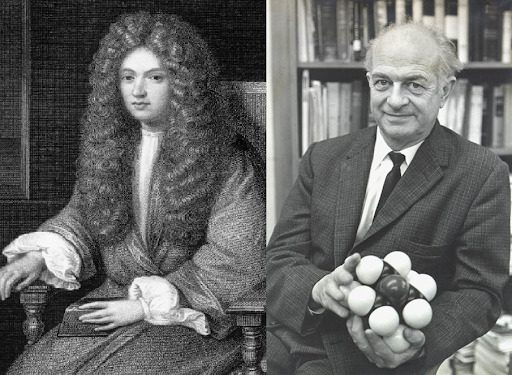Chemistry is a study of change. The intellect itself means the practice of constant change. However, even some of the greatest chemists would make permanent “Intellectual pauses” at certain areas outside of their main field of study. In this article, we will take a look at two of them and the duality of their legacies.
Robert Boyle: Physics, Chemistry & Religion
Robert Boyle (25 January 1627 – 31 December 1691) was an English physicist and chemist whose work extended beyond the main fields of research. He also had success in the fields of literature, philosophy, and so-called theology.
Contributions: Robert Boyle discovered the law of change in the volume of gases (particularly in the air) with a change in pressure. A number of his scientific works gained him the appellation of the “father of chemistry.”
Boyle studied a lot of chemical processes. For example, those occurring during the roasting of metals, a dry distillation of wood, the transformation of salts, acids, and alkalis. He introduced the concept of body composition analysis into science.
One of Boyle’s books was called The Sceptical Chymist. It defined the elements – as “original and simple, completely unmixed bodies, which are not composed of each other, but represent those constituent parts of which all the so-called mixed bodies are composed and into which they can be decomposed latter”
Boyle formulated the concept of “primary corpuscles” as elements and “secondary corpuscles” as complex bodies. He also explains for the first time the differences of various aggregation of bodies. Boyle obtained acetone by distilling potassium acetate. He developed a new method for obtaining phosphorus from bones, receiving orthophosphoric acid and phosphine.
Downside: he demanded miners to report him at what level of the ground depth they get to the abode of demons and precisely describe how exactly their nests look like.
The other side of Robert Boyle’s work was religion. In his youth, succumbing to various temptations he even thought about suicide, from which he was restrained by fear and the thought that the soul of a sinner would go to hell. Boyle wrote that the demon took advantage of his melancholy, “filled his soul” with terror, and inspired doubts about the basic truths of religion.
To allay these doubts, Boyle began reading the Bible and studied Hebrew and Greek to read it in the original. Boyle went on to become a zealous Christian and a remarkable religious writer. Even in scientific works, Boyle strove to prove the greatness and wisdom of the creator. The theory of corpuscularism had a very characteristic feature for Boyle – he considered corpuscles to be the smallest “tools”. “Tools” because of which the world we see is somewhat like a “giant clock” set in motion by God.
As a deeply religious person, Boyle strove to do his best to spread the word about Christianity. At his own expense, he translated the Bible into Irish and Turkish and bequeathed to hold annual religious readings, leaving the capital for this. And of course, he also believed that demons and their nests can be spotted by miners
Linus Pauling: Physics, Chemistry, Political Activism & Preaching of Antiscientific Theory
Linus Carl Pauling (February 28, 1901 (1901-02-28) August 19, 1994) – physicist, chemist, crystallographer, pacifist, and double laureate of Nobel Prize.
Contributions: in the early 1960s, Pauling was one of the world’s most respected figures of the 20th century. He combined quantum physics with chemistry, made an invaluable contribution to understanding the nature of chemical bonds, and laid the foundations for the theory of native and denatured proteins.
In addition to his chemical milestones, Linus also was passionately involved in social activities, agitating humanity against the development and proliferation of nuclear weapons. For his achievements in the field of chemistry, Pauling received the first Nobel Prize in 1954, and for his political activism, he was also awarded the Nobel Peace Prize in 1962.
Downside: soon after receiving the honorary awards, the process of turning the eminent scientist into an obscurantist has begun. It all started with a letter from some Irwin Stone, who wrote to Pauling that if a 65-year-old scientist at that time can live to at least ninety years old if he consumed 3000 mg of vitamin C every day (for comparison: the daily dose of this substance, depending on gender and age is 40-90 mg).
Pauling began to promote his unproven theory to the masses. In 1970 he published the book “Vitamin C and the Common Cold”, which became a bestseller and led to the fact that ascorbic acid became the # 1 commodity in pharmacies. And even though before and after the publication of the scientist’s book, many studies showed that “horse doses” of vitamin C do not bring any biological benefit, Pauling did not change his opinion. Those who knew him closely were not surprised by this attitude since Linus was an extremely vain person. He loved to point out other people’s mistakes, but he did not want to admit his own.
About the Author:
Zack Hargrove is a blogger. Many of his articles are dedicated to various topics of science. His colleagues from domycoding.com always look forward to assisting anyone with all sorts of coding difficulties.



































